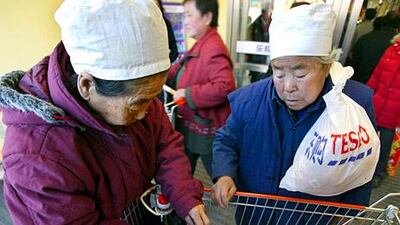Walk inside a Chinese branch of Tesco and you would struggle to tell the retailer was British.
There are countless types of soy sauce, pots of instant noodles, appetising tofu and every variety of green tea imaginable.
With its stores in China geared to the local market, the company has become a major force in the country's retailing with more than 100 supermarkets operating since opening its first in 2004.
Yet it faces hurdles in the world's second-largest economy, announcing last month it was closing four outlets in a "strategic adjustment". It came weeks after the company shelved a project to develop shopping malls to house its supermarkets.
"Its British management never understood the local market ... Tesco has a strong presence in Shanghai but in other cities, mostly hypermarkets in smaller cities, it's struggling. Many Tesco stores have poor performance," says Yujun Qiu, a China retail analyst with Planet Retail.
France's Carrefour, which pioneered hypermarket retailing in mainland China when it opened there in 1995, has also lost some of its sheen and like Tesco has slowed store openings.
"It got to know the local consumers very well. It had the first-move advantage ... but it never decided to invest heavily in the Chinese market. After about 20 years it still doesn't have one distribution centre of its own. It's aiming for short-term profits," says Mr Qiu.
Carrefour has restructured its management model after concerns store managers were too independent. Also, this year the company was forced to temporarily close a store after mislabelling products, foreign retailers being particularly vulnerable to being targeted by local officials.
Last month, after disposing of operations in five countries since 2009, Carrefour denied rumours it was jettisoning its China business as it tries to cut costs amid tough trading conditions in Europe.
While the company insists it is committed to expansion, now might not be the time for retailers to look to the dragon economy as their saviour, despite recent figures showing 13.1 per cent year-on-year overall retail sales growth.
Rising rental fees, especially, pose a challenge to operators, cutting profits.
"Besides property, other costs are increasing, such as labour costs," says Li Sheng, the deputy director of the China Chamber of Commerce Expert Working Committee, told state media recently.
For all its troubles, Carrefour posted annual sales in China of 42 billion yuan (Dh24.3bn) in 2010, more than three times Tesco's figure.
The other main western supermarket operator in China, Wal-Mart, has also had difficulties, suffering management upheavals because of its variety of store formats. But overall it appears to be in better shape than its rivals. It already has a strong presence in lower-tier cities, Wilson Chen, the manager of China market insights for Kantar Retail, points out. "Walmart has had a much smarter expansion strategy," he adds, saying the variety of store formats has advantages.
More broadly, as foreign chains expand further into the lower-tier cities, competition from local players is intensifying. RT Mart, based in Taiwan and partly French owned but seen as a domestic operator, has been the market leader for several years and has many successful smaller supermarkets.
"I think … overall there's a shift towards smaller, more local-style shops. Not mom-and-pop size but scaled down from the multiple square metres. Things need to be accessible," says James Roy, a senior analyst with China Market Research Group, adding Tesco seems to have adjusted to this more slowly.
Another issue is the differences across a "vast market" like China and these could explain why Tesco has found it challenging in certain cities.
"Compared with domestic retailers, [foreign chains] have a lack of understanding of shoppers and customised marketing campaigns to attract shoppers," says Mr Chen.
As well as worrying about the local players, western supermarket chains also face dynamic regional supermarket operators.
South Korea's Lotte group has what Mr Chen describes as "very ambitious expansion plans". It has 82 supermarkets in China and hopes to have 300 there by 2018.
Yet others, such as the do-it-yourself home-improvement retailer B&Q, show growth ambitions in China are not always realised.
In 2005, when it took over the operations of OBI in China, management forecast that by 2010 it would have annual sales in China of 15bn yuan from 100 stores in 30 cities. Instead, four years later, the subsidiary of Kingfisher based in the United Kingdom announced it was shutting 22 of its 63 stores and downsizing 17 others.
Prospects appear to have improved little, like-for-like sales in China having fallen in the first quarter of this year by 6.8 per cent.
The US Home Depot has found the going similarly tough: its store tally is now just half of its former peak of a dozen. Such struggles might appear surprising given China is engaged in the fastest urbanisation in history and private-home ownership is growing rapidly.
Yet, Mr Roy notes China has a "do it for me" approach to home improvement instead of the "do it yourself" philosophy of the big western chains.
Labour is cheap enough that homeowners prefer to hire others to do work for them.
Vast malls, where each storey contains multiple outlets specialising in areas such as home decoration or furniture, are more popular.
"There's a feeling you can get better value because you have multiple competing businesses in the same area," he says.
Sweden's Ikea is faring better, posting sales of 4.9bn yuan in China last year as it increases its store tally from eight at present to 15 by 2015.
Even so, this is modest expansion given the size of the Chinese market - and the fact the company has been operating there since 1998.
Another example, perhaps, of how tapping into what should be the world's largest consumer market often proves harder than expected.


